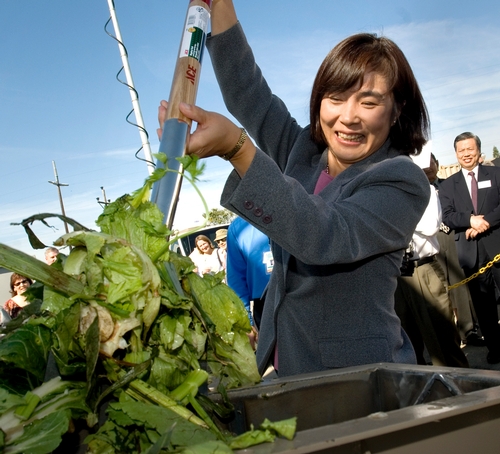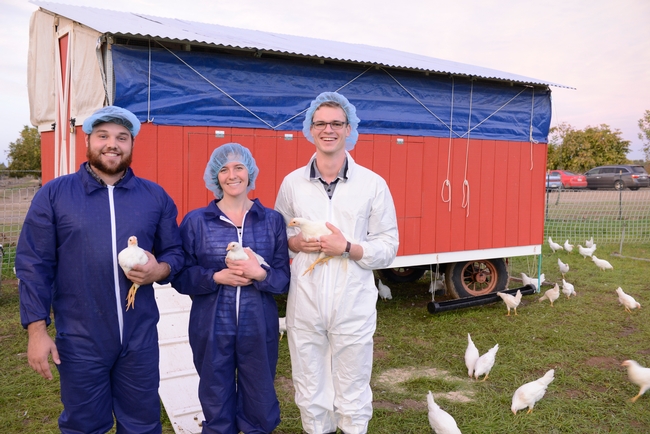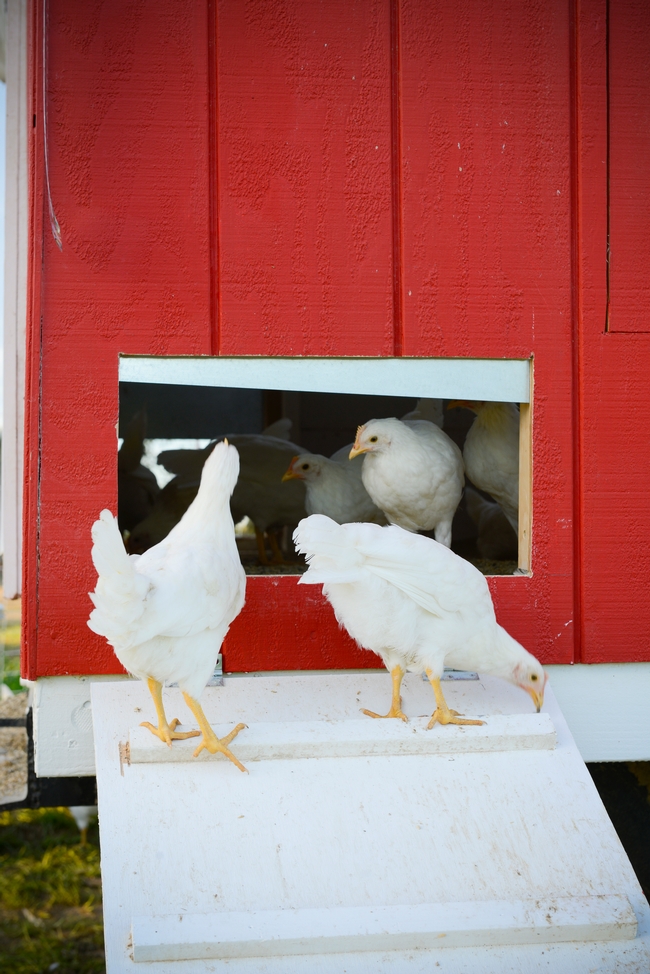Posts Tagged: engineering
Pastured poultry farm to foster innovation for small chicken farms
UC Agriculture and Natural Resources (UC ANR) provided seed money to launch a new Pastured Poultry Farm at UC Davis. The farm is home to 150 young chickens and a living laboratory where students and faculty researchers hope to develop innovative solutions benefiting pasture-based farms, integrative crop-and-poultry farms and backyard flocks.
Pasture-based chicken production offers many benefits as well as some challenges in terms of food safety, animal health and welfare, and environmental impacts, said Maurice Pitesky, UC ANR Cooperative Extension poultry specialist with the School of Veterinary Medicine and co-leader of the poultry project.
The new 4.5-acre farm, located about one mile west of the central UC Davis campus, includes a seeded, irrigated pasture, where the chickens can forage. In the center is a bright red student-built Eggmobile for night time housing. The ‘coop on wheels' can be strategically moved around the land for consistent fertilization. The pasture uses a portable electronic fence to protect against predators and is surrounded by a 50-foot band of uncultivated land to serve as a wildlife buffer.
“This is a unique innovation, research and outreach resource for the Western United States,” Pitesky said. “The project includes faculty and students with expertise in veterinary medicine, husbandry, welfare, pasture management and engineering, which allows us to address issues related to predator control, welfare, food safety and food efficiency.”
Debbie Niemeier, professor in the Department of Civil and Environmental Engineering, and her team have already developed a number of innovations for the project, including a tarp-pulley system, portable-shade and predator-mitigation structures, an automatic watering system, and modular roll-out nest boxes.
One of the advantages of the pasture-based system is the opportunity for a farmer to integrate chicken production with a farm's existing cropping system, with the chickens providing natural fertilizer for the crops.
“It's also a way for crop farmers to move into poultry production without expanding their land or adding nitrogen fertilizer to their farming system,” Pitesky said.
The new project is largely driven by students - drawn from the School of Veterinary Medicine, College of Engineering, and College of Agricultural and Environmental Sciences - who designed and constructed the Eggmobile. The mobile barn includes 32 nest boxes, each capable of accommodating several chickens. As it is moved to different locations in the pasture, chicken droppings gradually fertilize the grass. The student and faculty research teams will be delving into issues involving diseases and chicken health, predation by wildlife, and occupational health for workers.
Eggs produced by the project's flock will initially be donated to food shelters. The potential for eventual egg sales to the community is being explored. Eventually, the research team hopes to construct multiple Eggmobiles with different designs, and in time would like to expand the project to include broiler chickens, as well as cropping systems that integrate poultry, in order to fully maximize the potential of the land for food production.
A list of donors and other information about the UC Davis Pastured Poultry Farm can be found online. The School of Veterinary Medicine has established an online site where individuals interesting in supporting the UC Davis Pastured Poultry Farm financially can make donations.
Author: Patricia Bailey
Safety of GMOs debated online
Alison Van Eenennaam, UC ANR Cooperative Extension specialist in the Department of Animal Sciences at UC Davis, said research has shown that genetically engineered crops do not pose a risk to human health.
"There's a recent review paper where they summarized data from 1,700 different studies, and about half of those are publicly funded. And basically the results of those studies have been that there haven't been any unique risks or hazards associated with the use of this breeding method in the production of crops," she said.
The counter point was offered by Thierry Vrain, a soil biologist and genetic engineer with Agriculture Canada. He focused on the fact that more than 90 percent of the genetically engineered crops now in use were altered to be resistant to the herbicide glyphosate. He said this fact results in overuse of the herbicide.
"In terms of specific toxicity of the molecule glyphosate, which has very little acute toxicity - as it is advertised, it is safer than table salt. But in terms of chronic toxicity over time, over weeks and months, it will damage the microbiome and induce all kinds, all kinds of symptoms. In mice, and probably in humans," Vrain said.
Van Eenannaam tried to keep the discussion focused on the safety of GMOs.
"I think the most misunderstood thing is it's a breeding method that can be used to introduce all sorts of crop traits into crops and animals, and we always seem to get discussing the one particular application rather than looking at how it could be used to address many different problems that are associated with agriculture, including things like drought tolerance, disease resistance, biofortification of crops," she said.
Vrain agreed with most of Van Eenennaam's points.
"I agree with you, Alison, that GMOs are not necessarily toxic, et cetera, et cetera," he said. "There's all kinds of benefits, it's a very powerful technology. Used properly, it's probably very beneficial to humanity.
At the end of the debate Vrain reiterated his concern that the preponderance of GMOs are for glyphosate-resistant crops.
Biodigester turns campus waste into campus energy
Last week, on Earth Day, the university and Sacramento-based technology partner CleanWorld unveiled the UC Davis Renewable Energy Anaerobic Digester (READ) at the campus' former landfill. Here, the anaerobic digestion technology Zhang invented is being used inside large, white, oxygen-deprived tanks. Bacterial microbes in the tanks feast on campus and community food and yard waste, converting it into clean energy that feeds the campus electrical grid.
“This technology can change the way we manage our solid waste,” Zhang said. “It will allow us to be more economically and environmentally sustainable."
It is the third commercial biodigester CleanWorld has opened using Zhang's technology within the past two years and is the nation's largest anaerobic biodigester on a college campus.
The system is designed to convert 50 tons of organic waste to 12,000 kWh of renewable electricity each day using state-of-the-art generators, diverting 20,000 tons of waste from local landfills each year. It is expected to reduce greenhouse gas emissions by 13,500 tons per year.
The READ BioDigester encompasses several of the university's goals: reducing campus waste in a way that makes both economic and environmental sense, generating renewable energy, and transferring technology developed at UC Davis to the commercial marketplace.
The biodigester will enable the more than 100 million tons of organic waste each year that is currently being landfilled in the U.S. to be converted to clean energy and soil products. The READ BioDigester is a closed loop system, moving from farm to fork to fuel and back to farm. Whatever is not turned into biogas to generate renewable electricity can be used as fertilizer and soil amendments — 4 million gallons of it per year, which could provide natural fertilizers for an estimated 145 acres of farmlands each day.
Nearly half of the organic waste, or feedstock, needed to operate the biodigester to full benefit will come from UC Davis dining halls, animal facilities and grounds. CleanWorld is working with area food processing and distribution centers to supply the remaining amount. Meanwhile, UC Davis will earn 100 percent of the project's green energy and carbon credits and receive all of the electricity generated.
Anaerobic digestion is an age-old process. However, Zhang's patented technology made it more efficient — capable of eating a broader variety and bigger quantity of waste, turning it into clean energy faster and more consistently than other commercial anaerobic biodigesters.
View a video about the UC David biodigester here:
(This blog post is condensed from a UC Davis news release about the biodigester.)
Additional information:
- Read the full press release
- Download biodigester photos
- Vine video: From lunch to lights
- Visit http://www.cleanworld.com/
Where's Charlotte?
A spider web is one of nature's most marvelous wonders. It's art, it's architecture, and it's engineering. The silk is as beautiful as it is...

Backlit by the morning sun, a spider web glows, glistens and glitters. (Photo by Kathy Keatley Garvey)

A spider's dinner, all wrapped and ready to eat: a honey bee. (Photo by Kathy Keatley Garvey)
How UC helped turn onion waste into clean energy
Ten years ago, a California family's food-processing business was booming -- so much so that it was in danger of drowning in its own success. A new idea out of UC Davis helped them stay on top.
In 1983, Gills Onions had been asked by La Victoria Salsa to provide large quantities of high-quality, fresh-cut onions when no automated equipment and processes existed. With typical farmers’ "can do" attitude, brothers Steve and David Gill and their 16 employees developed a system to peel, slice, dice and deliver the first fresh-cut onions in the food processing industry.
By 2000, the Gills and their 400 employees were processing millions of pounds of sliced and diced onions weekly for restaurants, salsa makers and grocery stores. They had become the largest fresh-cut onion processor in the nation.
But they were being buried in onion waste -- the unused tops, tails and skins, which account for about 40 percent of the original onion mass.
Previously, their solution had been to truck these onion leftovers from their Oxnard processing plant to surrounding farm fields and plow them into the soil as compost. But now they had so much waste – up to 1.5 million pounds every week - that this solution had become too costly and environmentally unsustainable.
So they went looking for new ideas. They found them in the bright minds and laboratories of UC Davis research scientists and students.
UC Davis engineering professor Ruihong Zhang, a leading innovator with a passion and genius for turning food waste into energy, determined that onion juice was very good food for methane-producing microbes. With her research data, Gills’ engineers and contractors developed an anaerobic digester system that turns their leftover onions into electricity.
They squeeze the onions, feed the juice to the microbes, and use the methane that the microbes excrete to run a fuel cell that makes electricity.
Today that electricity powers the Oxnard processing plant. This year, they expect to save $700,000 on power bills and $400,000 on trucking costs. (They even sell the squeezed-out onion pulp, as a high-quality cattle food.)
Thanks to Professor Zhang and the University of California, Gills’ waste problem is now an energy source and new product line. The firm expects to make back its $9.5 million capital investment in six years.
And they are famous in the produce and energy industries. People come from all over the world to learn from their experience. They are winning engineering and environmental awards. (They are especially proud of beating the Dallas Cowboys' new $3 billion super-high-tech football stadium in a competition by the American Council of Engineering Companies.)
The help Gills Onions needed with their business problem was available to them, and the rest of the world, in part because California's public research universities get financial support from the private sector. In Ruihong Zhang's UC Davis lab alone, in the seven years she has been perfecting waste-to-energy technology, six donors (including Gills Onions) have given $221,000 to pay graduate student researchers' stipends, tuitions and fees; pay postdoctoral scholars; and purchase bioreactors and laboratory supplies. They also have donated $305,000 worth of equipment.
In fact, California's public colleges and universities have done more to make this state an international agricultural powerhouse than most of us realize. Yet state funding for public universities is unpredictable, and when universities seek philanthropic support, they risk criticism that they are privatizing or selling out – even though private support remains a small percentage of public university budgets (at UC Davis, it’s less than 7 percent).
The University of California needs California businesspeople to support its programs -- with their influence and their wallets. What sector of the state has more to lose if the new ideas dry up?

(Photo: Karin Higgins, UC Davis)





